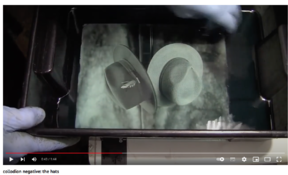I see that I need to bleach it before toning.
Yes. You could also try a direct sulfur toner, but it'll be slow, smelly and probably won't gain you much density.
Is bromide that you suggest potassium bromide, I assume?
Yes, absolutely. Table salt would work, too, btw. But potassium bromide is a safe bet. Copper sulfate is also fairly easy to get hold of. Some people in the US use tree root killer which apparently is copper sulfate.
The ratios aren't very critical. I always kept a jar (300ml or so) at hand that I initially mixed a teaspoon of both ingredients into. With use, the solution turns from a bright blue to a more pale blue and when it got slow, I would add a little copper sulfate and/or potassium bromide.
I don't remember where I read the 'trick' of the copper bleach. If you google for "
collodion negative copper sulfate" you'll find plenty of hits. Root around a bit and you'll see it's not complicated.
The procedure is really simple: just mix the copper sulfate bleach as outlined above. After fixing and thoroughly washing your collodion negative, put it in a tray and pour the bleach onto it. Agitate until the image turns bright white throughout. This usually takes (much) less than a minute. Then wash the plate again.
If you don't want to use a copper sulfate bleach, try a regular ferricyanide bleach - the kind that's sold as part of odorless sepia toner kits etc. It'll be slower than the copper sulfate, but should work just as well.
What you now have is basically a plate with your image on it, with the image consisting of silver bromide (or silver chloride if you used table salt instead of potassium bromide) - i.e. a silver halide image. This image can now be redeveloped. It doesn't require re-exposure to UV light; I've always just done the bleaching and washing in normal room light and that seemed to work just fine. You could chuck the plate (in its tray) underneath a UV light source if you want, for a minute or two. It won't hurt.
This silver halide image gives you some options of how you want to re-develop it. Obvious choices are:
- Thiourea sepia redevelopment. This will give a modest UV-density gain. Any odorless sepia toner (bath B) will work. These toners are a small amount of thiourea and a small amount of sodium hydroxide in water.
- Redevelopment with any paper or film developer of your choice, including tanning/staining developers. This in principle won't give you much of a density boost, but a staining developer will give some extra UV density due to the stain. However, it'll also make the emulsion come off the plate fairly easily (due to the tanning action, it contracts and it can dislodge from the plate/flake off). Due to the limited density gain, I never used this apart from a few experiments.
- Intensification by washing the plate in a weak silver nitrate solution. This gives a dramatic contrast boost. I added a bit of nitric acid to this to prevent fog and to keep the silver nitrate in solution even if it contaminated a bit with halides. Basically, a dilute version of your collodion silver bath! The concentration of the bath isn't critical. I used something around 1% and that was plenty strong enough.
After treatment, wash thoroughly. If you do silver intensification, you can actually repeat the process as many times as you want to build massive amounts of density on your plate. I've done it up to 3 times or so on very underexposed plates, turning them into absolutely bulletproof negatives (with little shadow detail). This worked really great for salted paper prints and it should work magnificently for carbon transfer as well - I think Borut Peterlin uses this method as well or at least has used it for some time. Don't quote me on that, though.
A key point is that concentrations of the chemicals really isn't very critical at all in either the bleach or the redevelopment process. This is really something where a dash of this and half a teaspoon of that will work just fine.
Have fun with it; this is a really powerful tool if you're into the combination of wet plate photography and alt. process printing.












